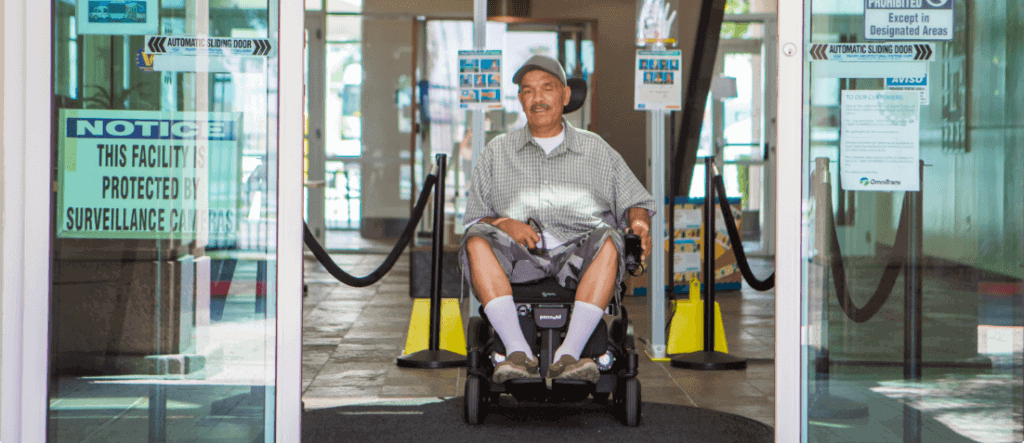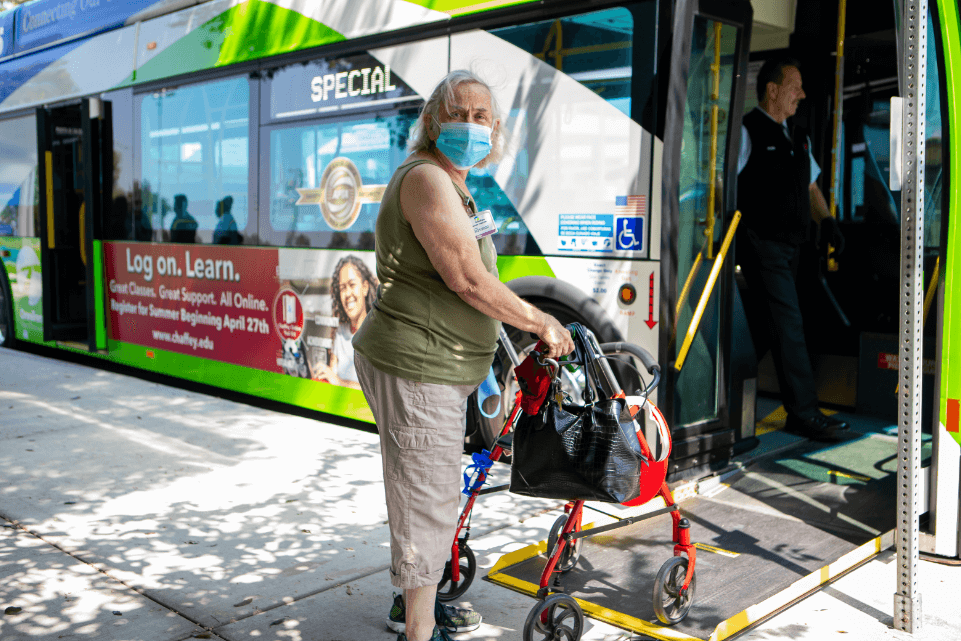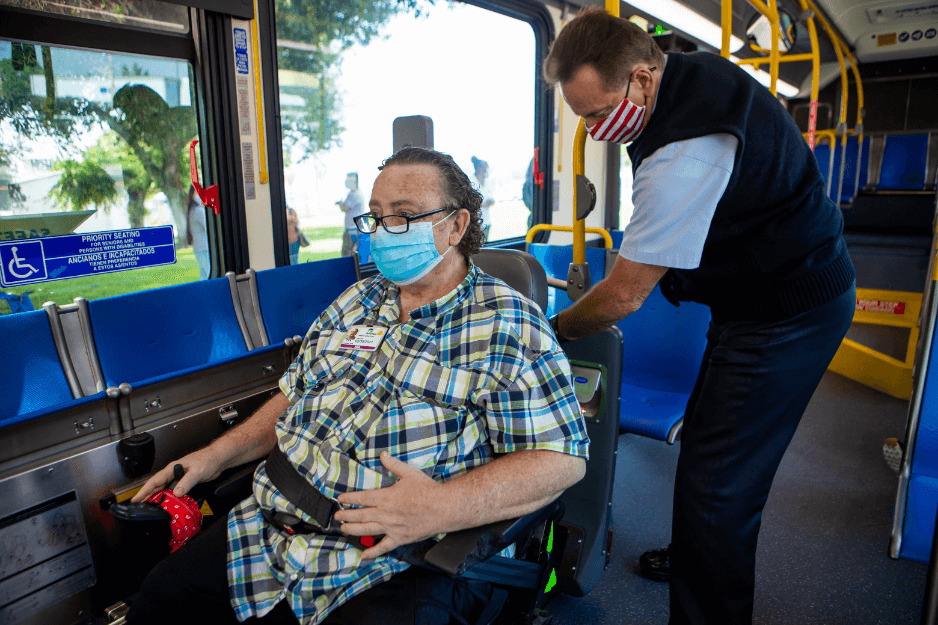ADA, Modifications, & Mobility Devices
Omnitrans is committed to accommodating persons with disabilities.

ADA Compliance
In compliance with the Americans with Disabilities Act (ADA), Omnitrans makes accommodations for persons with disabilities who wish to use any of our services. These include but are not limited to wheelchair accessible ramps or lifts and securement areas on all buses; low floor kneeling buses; audio and visual on-board bus stop announcements; and TDD/TTY access via the California Relay Service, 711.
Omnitrans is committed to ensuring that no person is denied access to its services, programs, or activities on the basis of their disabilities, as provided by 49 CFR 37 of the Americans with Disabilities Act of 1990.
Access Service
Omnitrans also provides Access, a curb-to-curb transportation service for people with disabilities who are unable to independently use the fixed route bus service.
Learn more about OmniAccessADA Complaints
If you wish to make an ADA-related complaint, you may contact us by phone, email, mail or using our online form.
1700 W. Fifth St. San Bernardino, CA 92411
Submit a complaint onlineReasonable Modification
Upon request, Omnitrans shall make reasonable modifications in policies, practices, or procedures when the modifications are necessary to avoid discrimination on the basis of disability or to provide program accessibility to its services, subject to the limitations of 49 CFR §37.169(c)(1)-(3). When possible and practical, individuals with disabilities who wish to request a modification should do so in advance of using Omnitrans services. The request from the individual with a disability should be as specific as possible and include information on why the requested modification is needed in order to allow the individual to use Omnitrans services.
Requests for modification of Omnitrans’s policies and practices may be denied only on one or more of the following grounds:
- Granting the request would fundamentally alter the nature of Omnitrans’s services, programs, or activities;
- Granting the request would create a direct threat to the health or safety of others; or
- Without the requested modification, the individual with a disability is able to fully use Omnitrans’s services, programs, or activities for their intended purpose.
In any case in which Omnitrans denies a request for a reasonable modification, Omnitrans shall take, to the maximum extent possible, any other actions to ensure that the individual with a disability receives the services or benefit provided by Omnitrans.
Please note that Omnitrans is not required to accommodate devices not primarily designed for use by individuals with mobility impairments. This includes items such as shopping carts, bicycles, and skateboards. In addition, Omnitrans is not required to permit other types of assistive devices to be used in ways that depart from or exceed their intended uses.
Submit a Reasonable Modification request by phone, email, or mail
1-800-966-6428 (1-800-9-OMNIBUS)
1700 W. Fifth St., San Bernardino, CA 92411


Riding with a mobility device on Omnitrans buses
All Omnitrans buses are equipped with lifts or ramps to board wheelchairs and other mobility devices. They may be used by persons with disabilities who cannot use the steps to board the bus, including riders using the following devices:
- wheelchairs
- scooters
- orthopedic strollers or similar mobility devices
- walkers
- canes
- crutches
- portable oxygen units
Omnitrans will make every attempt to accommodate the rider’s mobility device. Omnitrans buses may also “kneel” on request for easier boarding by orthopedically challenged riders; some stop locations may not suitable for the bus to kneel.
How to use a lift or ramp with a wheelchair or mobility device
- Wait at the bus stop and indicate to the driver that you need to use the lift/ramp. Position yourself to be in the clear as it deploys.
- Wait for the driver to tell you to move on to the platform. When on the lift, set the brake on your wheelchair or mobility device; if you are standing, hold onto the handrails for support.
- Pay your fare and tell the driver your destination so the bus can be positioned correctly at your stop.
- When using a wheelchair or scooter, move to the special seating area and set your brake.
- When using a mobility device, allow the coach operator to secure your mobility device with clamps or straps that are stored on all buses.
- Signal the driver about a block before your stop to remind the driver you want to exit the bus. The driver will allow other riders to board and exit before releasing mobility device restraints. The driver will advise you when to proceed.
- When exiting, wait until the lift has reached the ground and the safety barrier has dropped before moving off the platform.
In according with the Code of Federal Regulation 49, Subpart G, 37.165 (c) 1.3, your coach operator will secure your mobility device with clamps or straps that are stored on all buses. Coach Operators will decline to provide service to a rider who refuses to allow his or her mobility device to be secured.
- Passengers in wheelchairs/mobility devices should board at the middle door at curbside stations and the forward door at center-line stations.
- Each vehicle offers two positions for mobility devices including one rear-facing, self-securement position.
sbX stations have a host of ADA-friendly features designed to make sbX accessible, safe, and comfortable for riders with disabilities:
- Wheelchair-accessible station ramps and waiting areas.
- Level boarding at platform stations eliminates the need for hydraulic lifts or ramps for boarding or exiting, making it easier by foot or wheelchair; a bridge plate can be deployed to cover the gap for wheelchairs.
- Communications system at crosswalks, with an audible sound that helps alert people at crosswalks.
- Planter boxes and textured floor strips along walkways and station platforms help people with visual impairments navigate on and around the platforms.
- Braille & audio options at TVMs; CS and Emergency phones are accessible to mobility devices.